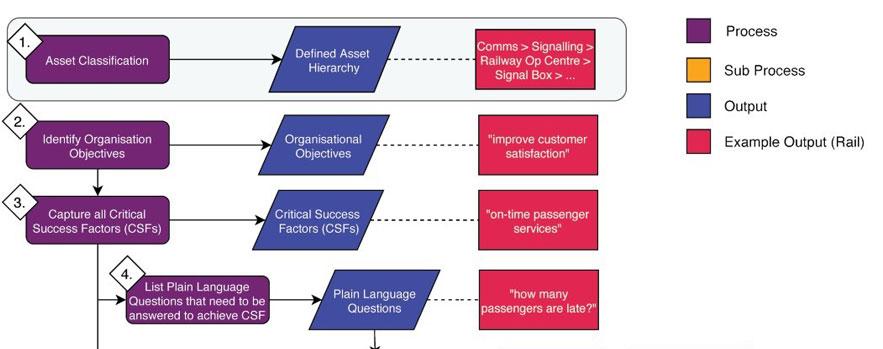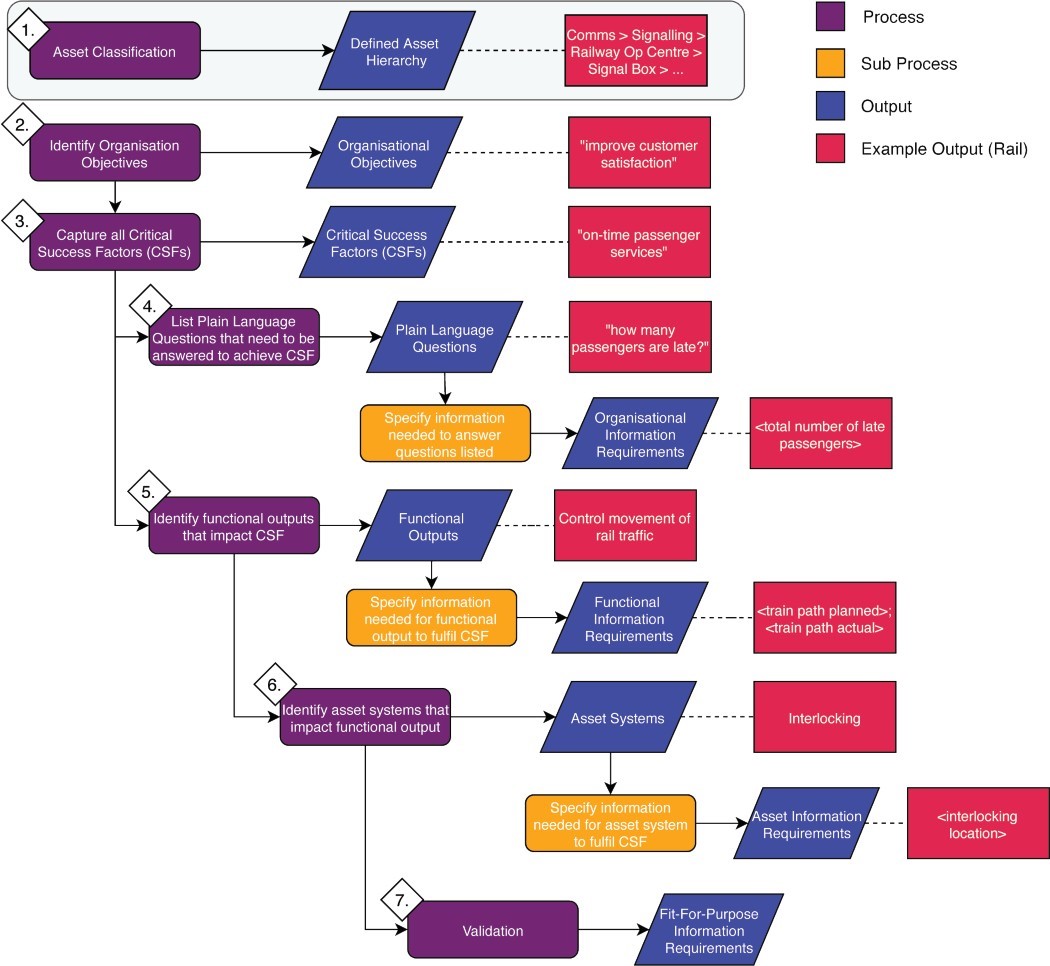
(This page covers the research leading up to the Line of Sight Methodology, For more information on the Line of Sight Methodology itself please follow this link.)
Organisations responsible for infrastructure assets must understand the importance that asset information has to achieving their organisational objectives. Despite the potential benefits of effective information management to optimise digital opportunity, many organisations still struggle to identify what information should be collected to support the efficient management of assets throughout their whole life.
Asset-related information not collected in alignment to organisational requirements can restrict the performance of capital investment decisions, risk management and operational performance throughout the whole life of the asset and ultimately impact productivity.
Network Rail should implement this method or similar now as there is a lot of data currently not being captured effectively that should be.
Penny Robinson, Programme Change Manager, Network Rail
Standards such as the PAS 1192 series and ISO 19650 describe the approach that organisations should take to define their asset information requirements (AIR) and the asset information model (AIM). The AIR should be informed by the organisational information requirements (OIR), which in turn is defined based on organisation objectives. However, the standards do not prescribe how this should be achieved and what processes should be used.
CSIC researchers have developed a top-down methodology that supports the development of AIR in relation to OIR and addresses the disconnect between the PAS/ISO BIM-related standards and asset management standard ISO 55000. The novel aspect of this approach is the development of Functional Information Requirements (FIR) to bridge the gap between the OIR and the AIR. This is achieved by identifying and understanding the ‘functions’ of the asset systems that help address or have an impact on the OIR, to then identify the assets that form each function.
Industry collaboration to test the value of the asset management framework
The methodology is currently being tested within industry as part of a CSIC secondment project with a member of the Asset Management Team from CSIC Industry Partner, Jacobs. The Asset Management Team is supporting Network Rail in delivering the Transpennine Route Upgrade (TRU) – a major railway enhancement to improve connectivity between York and Manchester. TRU involves upgrading existing assets and installation of new assets to deliver a railway that will leave a lasting legacy. Exploring the benefits, challenges and opportunities of the methodology for Network Rail facilitates the longer-term possibility for a digital twin of the TRU, which would require whole-life data collection and management from the starting point of the programme and throughout design, construction, operation and integration.
Application tool to identify organisational objectives A wide range of Network Rail strategic documents were collated to identify organisational objectives. In order to reduce time required to read large volumes of text, an algorithm-based tool using data- mining techniques was developed to search the text and identify locations of organisational objectives. More than 60 objectives were sense checked and put into the following categories: operational; reputational; customer; financial; environmental; and health and safety. For the purpose of testing the methodology within the secondment timeframe of four months, one organisational objective was selected: improve customer satisfaction.
The top-down methodology creates a two-way line of sight from organisational objectives to asset requirements with functional requirements located between the two. A sample of FIR and AIR aligned to the identified organisational objective was captured. This approach helped deconstruct siloed structures familiar to many organisations and enables a systems perspective.
A seven-step process provides a rigorous methodology and holistic approach capturing interfaces between asset disciplines and types – see the framework opposite. The methodology clarifies why an organisation needs specific asset information, which ensures data collected has a clear purpose making it possible to optimise value. Being able to classify data is particularly helpful in the context of the UK government’s commitment to achieving net-zero carbon emissions by 2050 making the carbon cost of data a consideration. It also enables classification and curation of data throughout the whole life of the asset, making data accessible to any asset manager and operator.
Establishing a ‘golden thread’ of valued information offers insight, it enables better decision-making and safeguards an organisation against the consequences of bad decisions.
Identifying value to Network Rail
A series of workshops were organised for a number of senior Network Rail representatives to explore the methodology, test the framework and identify its value in relation to the TRU Programme and Network Rail. To ensure the framework’s user accessibility and avoid the necessity of referring to spreadsheets of information, CSIC and Jacobs developed a web app streamlining the three-layer framework process. The web app helped record information requirements during the workshop
and was developed with a view to being used throughout Network Rail’s TRU upgrade programme, and potentially be applied to future projects and programmes. Feedback about the framework from attendees was very positive and recognised the added value and business case to Network Rail from curating data for future use and whole-life operation. Network Rail recognised the potential value of applying an information management framework to support organisational objectives.
Challenges and opportunities
While applying this methodology to an organisation’s entire asset estate requires considerable investment of time and related costs, the potential benefits of this framework are considerable and include long-term yield. The flexibility of the methodology makes it suitable to apply to a single project, such as the TRU programme, or at scale. The process brings wider benefits that prepare an organisation to be well positioned to optimise opportunities presented by digitalisation. Organisations without adequate data and information management will be left behind.
This CSIC and Jacobs secondment has resulted in an information management framework that is both useful for and usable by industry.
Key benefits of the framework
Benefits of applying this methodology include:
• Identifying gaps in information capture
• Establishing line of sight from asset information to organisational objectives
• Providing holistic process capturing interfaces between asset disciplines/types
• Allowing better decision-making to optimise performance and manage risk throughout the whole life of the asset.
In addition, two applications have been created as part of the secondment project which can be used by all collaborating partners – Jacobs, Network Rail and CSIC – on future projects.
Our infrastructure assets are required to give service over a long period of time and existing assets form the greatest part of the UK’s total infrastructure; each year in this country we add just 0.5 per cent to the capital value of the assets we have inherited1.
Having a line of sight from asset information to organisational objectives enables an organisation to be agile if circumstances, such as extreme weather events and the consequences of climate change, require organisational objectives to change.
CSIC Team: Dr Ajith Parlikad, Dr Jennifer Schooling, Dr James Heaton
Secondment: Aaron Johnson, Senior Asset Management Consultant, Jacobs
1 Smart Infrastructure: Getting more from strategic assets, CSIC and industry partners, June 2017

